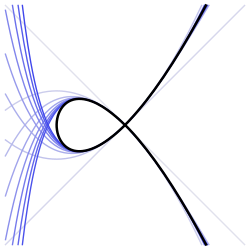Puiseux series

Puiseux series is a fancy way of writing down equations that explain how things expand out around a point in mathematics. It's like a secret code that helps us understand how strange shapes and functions behave when we look at them up close.
Imagine you have a puzzle with a piece that doesn't fit quite right - you can't figure out how to connect it with the others. But if you look at that one piece really closely, you might start to see little lines and curves that can tell you how it fits in with the rest of the puzzle. In the same way, Puiseux series can help us see the little patterns and shapes that might be hidden in complicated math problems.
Puiseux series can be used to solve equations that can't be solved with normal arithmetic. For example, if you have an equation that looks like x^2 + y^2 = 1, you can solve it by saying "x equals the square root of one minus y squared" or "y equals the square root of one minus x squared". But what do you do if the equation is really complicated, like x^3 + y^3 = 1, or x^5 + y^5 = 1?
This is where Puiseux series come in. They show us a way to write down solutions to these more complicated equations as a series of terms that get smaller and smaller as we move away from a certain point. It's like a way to zoom in on the problem and see what's going on in more detail.
For example, if we use a Puiseux series to solve the equation x^3 + y^3 = 1 with respect to x, we might write it like this:
x = 1 - (y/3)^(1/3) - (2/27)*y^(2/3) - (19/243)*y^(4/3) - ...
Each term in the series gives us a little more information about the shape of the curve around the point we're looking at. It might not make sense to us right away, but to a math expert, these series are very powerful tools that can help us understand how complicated functions work in more detail.
Imagine you have a puzzle with a piece that doesn't fit quite right - you can't figure out how to connect it with the others. But if you look at that one piece really closely, you might start to see little lines and curves that can tell you how it fits in with the rest of the puzzle. In the same way, Puiseux series can help us see the little patterns and shapes that might be hidden in complicated math problems.
Puiseux series can be used to solve equations that can't be solved with normal arithmetic. For example, if you have an equation that looks like x^2 + y^2 = 1, you can solve it by saying "x equals the square root of one minus y squared" or "y equals the square root of one minus x squared". But what do you do if the equation is really complicated, like x^3 + y^3 = 1, or x^5 + y^5 = 1?
This is where Puiseux series come in. They show us a way to write down solutions to these more complicated equations as a series of terms that get smaller and smaller as we move away from a certain point. It's like a way to zoom in on the problem and see what's going on in more detail.
For example, if we use a Puiseux series to solve the equation x^3 + y^3 = 1 with respect to x, we might write it like this:
x = 1 - (y/3)^(1/3) - (2/27)*y^(2/3) - (19/243)*y^(4/3) - ...
Each term in the series gives us a little more information about the shape of the curve around the point we're looking at. It might not make sense to us right away, but to a math expert, these series are very powerful tools that can help us understand how complicated functions work in more detail.
Related topics others have asked about:
